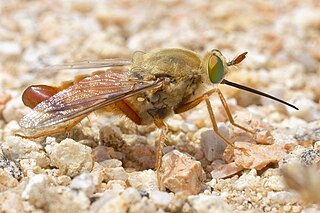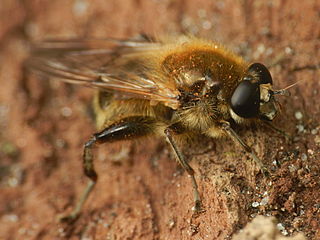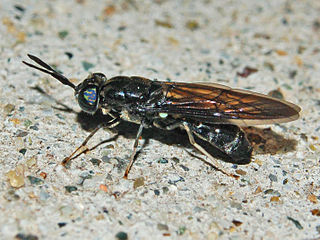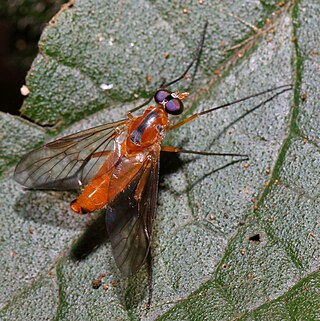
Carl Robert Osten-Sacken or Carl-Robert Romanovich, Baron von der Osten-Sacken, Baron Osten Sacken was a German-Russian diplomat and entomologist. He served as the Russian consul general in New York City during the American Civil War, living in the United States from 1856 to 1877. He worked on the taxonomy of flies in general and particularly of the family Tipulidae.

The mydid fly genus Rhaphiomidas contains fewer than 30 species/subspecies, all of them occurring in the desert regions of the southwestern United States and adjacent portions of northwestern Mexico. The adults are most commonly encountered in sand dune areas, and are typically only active for a few weeks each year, either in the spring or the fall; in some cases, more than one species can occur in the same dune system, but they are allochronic, each flying in different seasons. Almost nothing is known about their biology, though eggs or early instar larvae of some species are laid on the soil surface and appear to be attractive to ants, and are brought into the ant nest. The restriction to sand dune areas has unfortunately led a number of these flies to the brink of extinction, especially both subspecies of R. terminatus, and the species R. trochilus. While there is only one of these on the Endangered Species List, many of the remaining taxa - including a few that have not yet been named - are gravely imperiled, as they are restricted to small geographic areas, rendering them extremely vulnerable to habitat loss or disturbance. These habitats are heavily targeted for development, and even if not, activities such as sand mining or motorized off-roading are common, and render the habitat unsuitable for the survival of the flies.

Scellus is a genus of flies in the family Dolichopodidae. It is distributed in the Palearctic and Nearctic.

Brachypalpus is a genus of hoverflies, from the family Syrphidae, in the order Diptera. The head is triangular and produced well forwards and somewhat downwards. The thorax and abdomen with pile often rather long. The hind femur is swollen and with an obtuse spur apically and ventrally. The hind trochanters of male is spurred.
The larvae are of the rat-tailed type feeding on decaying sap under tree bark. Larvae live in decaying trees and logs. Larva and pupa have been described by Malloch.

Hermetia is a genus of flies of the family Stratiomyidae.

Panopinae is a subfamily of small-headed flies (Acroceridae). Their larvae are endoparasites of spiders in the infraorder Mygalomorphae.
Eutreta is a genus of the family Tephritidae, better known as fruit flies.

Diogmites is a genus of mainly neotropical flies in the family Asilidae or robber flies.

Anthracinae is a subfamily of bee flies in the family Bombyliidae. There are more than 80 genera and 2,000 described species in Anthracinae.

Tabanini is a tribe of horse and deer flies in the family Tabanidae. There are at least 220 described species in Tabanini.

Mydas is a genus of flies in the family Mydidae.
Lampria is a genus of robber flies in the family Asilidae. There are at least 20 described species in Lampria.
Ocnaea is a genus of small-headed flies. There are 20 described species in Ocnaea.

Philonicus is a genus of robber flies in the family Asilidae. There are at least 20 described species in Philonicus.
Lamprempis is a genus of flies in the family Empididae.
Philipotabanus is a genus of horse fly belonging to the family Tabanidae subfamily Tabaninae.

Suragina is a genus of flies in the family Athericidae.
Artemita is a genus of flies in the family Stratiomyidae.











